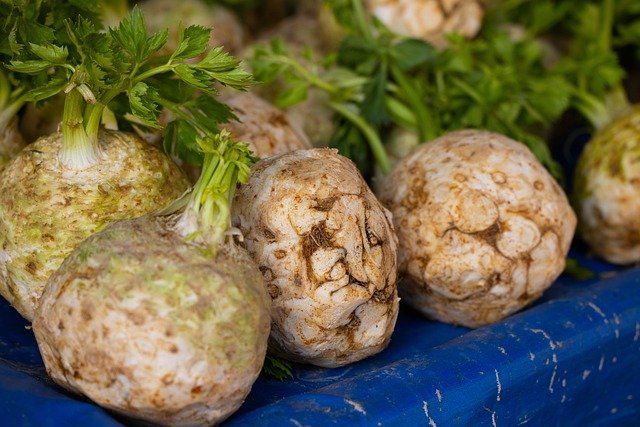
Celeriac is an “ugly but good” vegetable, let’s see why celeriac is good for you, what its properties are and how to use it in cooking.
Celeriac, as well as celery, but also like parsley and carrots, belongs to the Umbelliferae family. It is also known as “Verona celery” and this shows how this vegetable is better known and used in northern Italy, a little less in the south.
The leaves are similar to those of traditional celery, but the stems are hollow, while the root is very developed, gnarled on the outside and a brownish color, while inside it is light and delicate in flavor . It is a biennial plant, whose harvest takes place starting from August and lasts throughout the winter, in fact it is a vegetable that is typically in season in the winter period. Let’s now see what are the nutritional properties of celeriac.
Celeriac: calories and nutritional properties
Contrary to what one might think, given that it is a vegetable that grows mostly underground, celeriac has very few calories, 100 grams of product in fact provide 33 kcal and few carbohydrates.
Instead, fiber is abundant, equal to about 5% and water, equal to 88%. Of course, the fat content is almost zero and the proteins are well represented if you think that it is still a vegetable: almost 2 grams per 100 grams of product.
Celeriac is also rich in potassium, phosphorus, calcium, all minerals important for our well-being, to which are added the beneficial properties of the antioxidant compounds. Here in the details, the nutritional values of celeriac.
Nutritional values per 100g of white turnip:
- Kcal: 33
- Carbohydrates: 3.8 g
- Fat: 0.1 g
- Proteins: 1.9 g
- Fibers: 5.1 g
- Waterfall: 88.0 g
- Iron: 0.5 mg
- Soccer: 52 mg
- Sodium: 91 mg
- Potassium: 460 mg
- Phosphorus: 90 mg
- Zinc: 0.3 mg
- Vitamin B1: 0.07 mg
- Vitamin B2: 0.11 mg
- C vitamin: 6 mg
- Vitamin B3: 0.50 mg
- Vitamin B6: 0.08 mg
- Vitamin E: 0.52 mg
Celeriac: the health benefits
This vegetable, often little considered, deserves to be brought to our tables more often, since it boasts many beneficial properties for our health.
Celeriac is particularly rich in antioxidant compounds, which play a key role in reducing oxidative mechanisms, which are extremely harmful to our cells. These mechanisms are at the basis of many inflammatory diseases affecting the cardiovascular system, such as hypertension, dyslipidemia, excess abdominal fat, hyperglycemia. Let’s see the benefits of celeriac in detail.
✓ Digestive
Celeriac boasts digestive and purifying properties. Thanks to the fibers, in fact, it helps digestion and the absorption of nutrients and, thanks to the high water content, it helps the kidneys in the elimination of waste.
✓ Useful in lung diseases
Celeriac, thanks to the numerous antioxidant compounds it contains, is useful in the treatment of lung diseases with its anti-inflammatory and expectorant function.
✓ Remineralizing
As we have seen, celeriac contains many minerals, such as potassium, calcium, sodium, phosphorus, manganese, all essential not only for our bones, which are the storage areas of minerals, but for the proper functioning of the whole organism. since most of the chemical reactions underlying vital functions rely on the presence of these minerals as key cofactors.
✓ Anti-inflammatory
Celeriac, as already mentioned, contains many antioxidant compounds, such as apigenin, caffeic acid, ferulic acid, tannins. These compounds give it remarkable anti- inflammatory properties, so it is believed that celeriac is useful in the prevention of inflammatory diseases affecting various organs. Apigenin, for example, is able to act by inhibiting the production and action of many compounds that are part of the chemical reactions typical of inflammatory mechanisms, as various scientific studies demonstrate.
✓ Contrasts the formation of kidney stones
Having diuretic properties, consuming celeriac regularly may be indicated to prevent the formation of kidney stones.
✓ Ally of the cardiovascular system
Hyperglycemia, dyslipidemia, hypertension, are all conditions that determine the onset of the metabolic syndrome, with serious damage to the cardiovascular system. Celeriac has been shown to be rich in antioxidant compounds that can fight and prevent such conditions.
✓ Antitumor
Celeriac, like celery and parsley, contains a phenolic compound called apigenin, which has been shown in laboratory studies to have anticancer effects since it inhibits the growth of cancerous cells. For this reason, anticancer properties are attributed to these vegetables. In reality, however, it should be emphasized that these are laboratory studies and not clinical studies, that is, the studies on patients are not yet sufficient to support this hypothesis.
✓ Health of skin and hair
Also apigenin, thanks to its anti-inflammatory action, would be able to protect the skin, counteracting dermatitis and having a protective action from the sun’s rays. This action is also carried out on the scalp by counteracting inflammation of the integument, in fact this vegetable could have a protective and stimulating action for the hair follicle in case of baldness.
✓ Antihemorrhagic
Thanks to the presence of vitamin K, celeriac has anti- haemorrhagic properties, that is, it favors the coagulation processes of the blood and for this reason it must be consumed carefully by those who follow a pharmacological treatment with anticoagulants, because it could interfere with their action.
✓ Satiating
Also due to the presence of water and fiber, this vegetable lends itself well to being consumed as part of a low-calorie diet, because despite having a low calorie content, it has a satiating effect. Furthermore, let’s not forget the remineralizing effect, which should not be overlooked especially when following a low calorie diet.
Celeriac: how to cook and some tips for use
We can find celeriac in small and large fruit and vegetable markets and also in large-scale distribution. It is useful to have some precautions when choosing it: you have to make sure that it is firm to the touch and that it is not too big to avoid it being hollow inside.
The appearance is lumpy and often covered with earth but let’s not be fooled, its flavor is tantalizing and the pulp is white. Just as you buy it, it can be stored in the refrigerator for about 5 days.
When you intend to use it, you must first clean it to eliminate the earth residues accumulated on its surface and for this it could also be useful a brush. Once washed under running water and thoroughly cleaned, you can choose to consume it with or without the peel.
Since it is a vegetable that can be eaten both cooked and raw, if we decide to eat raw celeriac, it will be good to remove the outer layer with the help of a knife, as you would with a carrot. After that it can be sliced into strips or thin slices and added to a tasty and fresh salad with extra virgin olive oil and lemon: the taste of celeriac is similar to that of traditional celery.
If, on the other hand, we prefer to eat it cooked, there are numerous recipes in which we can use it. Cooking celeriac is very easy: you can simply boil it for 5 or 10 minutes reduced into cubes or sticks, or fry it in the form of chips, or put it in the oven or simply cook it in a pan for a few minutes.
We can then use it as a side dish for meat or fish dishes. In winter, however, we can prepare excellent soups (for example with onions and cabbage) and mashed potatoes, even together with potatoes that make the flavor more delicate, with the addition of cheese, a real delight!
Some tricks to preserve celeriac: remember that if we want to keep it after having peeled and cut it, we will have to add lemon juice so that it does not blacken and put it in the refrigerator in an airtight container.
Contraindications of celeriac
Celeriac contains allergenic substances, which in predisposed subjects could cause severe allergic reactions. In this case it is therefore useful to ask your doctor for advice. Given its antiplatelet properties, those who follow a therapy with anticoagulants must make a moderate consumption of it. In addition, those who take diuretics must also pay attention to consumption.






